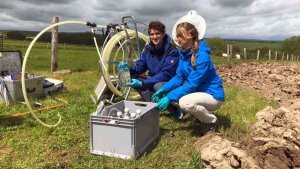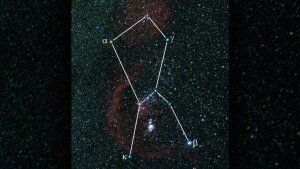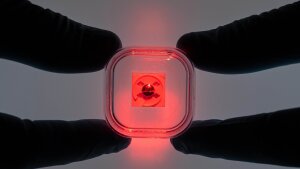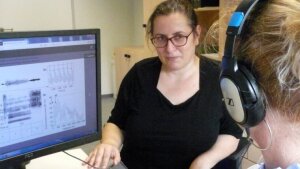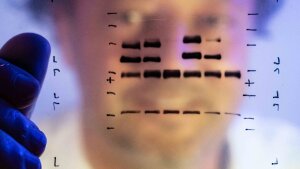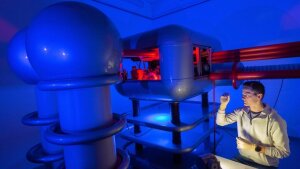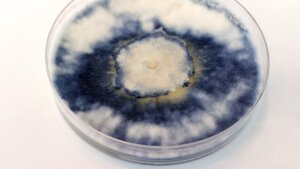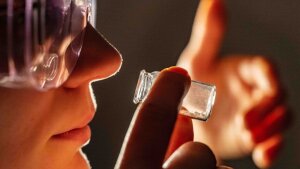Ticker
Life in the bowels of the Earth
Dr Will Overholt and Prof. Dr Kirsten Küsel during water analyses in the field.
Image: Beatrix HeinzeThe microorganisms found in aquifers deep below the Earth's surface produce similar amounts of biomass as those in some marine waters. This is the conclusion reached by a team of researchers led by the University of Jena and the German Centre for Integrative Biodiversity Research (iDiv).
They have used a unique, highly sensitive measuring technique with radioactive carbon to prove for the first time that these communities do not depend on solar energy in total darkness. Instead, they obtain their own energy from the rock oxidation or from compounds transported downwards. Their study has been published in »Nature Geoscience« (DOI: 10.1038/s41561-022-00968-5External link). [Tilch]
Red giant was once yellow
The constellation of Orion.
Image: Markus MugrauerAs nuclear fusion progresses within a star, there are changes in its brightness, size and colour. These properties provide astrophysicists with information about the age and mass of a star. Stars with significantly more mass than the sun are blue-white or red – the transition to red via yellow and orange occurs relatively quickly by astronomical standards. A team from the University of Jena has succeeded in reconstructing a highly precise time frame for this colour change. With the help of historical sources, they have found that Betelgeuse – the bright red supergiant in the top left of the Orion constellation (see photo) – was actually yellow-orange around 2,000 years ago. They have reported on their research results in »Monthly Notices of the Royal Astronomical Society« (DOI: 10.1093/mnras/stac1969External link). [sh]
The peregrine falcon's prey
Sliced samples of dust grains are studied at the Institute of Geosciences.
Image: Jens Meyer (University of Jena)An international team of researchers, including scientists from the University of Jena, have been examining soil samples that a Japanese space probe (»Hayabusa-2«) collected from the Ryugu asteroid. By analysing the extra-terrestrial material, the researchers have gained insights into the formation of the asteroid and the processes that took place in the first five million years after our solar system was born. The team has described its findings in »Science« (DOI: 10.1126/science.abn8671External link).
For example, the researchers have found evidence to suggest that Ryugu's »nursery« was not located near the centre of our solar system, where the asteroid can be found today, but in the outer regions. It is conceivable that Ryugu used to be a comet. As it got closer to the sun, the water evaporated to a certain extent, leaving solid dust behind.[Schimmel]
Test for recognizing voices
Respondent tests the »Jena Voice Learning and Memory Test«.
Image: Uta von der GönnaA team of researchers from the University of Jena developed a standardized test for voice memory. The aim of the »Jena Voice Learning and Memory Test«, which is freely available on the Internet, is to make research data on person perception more comparable, and it could also be used in clinical diagnostics or forensics in the future.
The test first introduces different male and female voices. In the next part of the test, participants have to pick out the voices they have learned several times from various audio samples. The test has been evaluated and proven to be a reliable tool for measuring a person's ability to learn and recognize voices. Thanks to the test, which has been published in »Behavior Research Methods«, the study team has even identified »super-recognizers« and »voice-blind« people (DOI: 10.3758/s13428-022-01818-3External link). [vdG]
New approach to tumour therapy
Cell lines that exhibit the characteristics of tumour cells are studied at the Institute of Biochemistry and Biophysics.
Image: Jens Meyer (University of Jena)A novel method for treating malignant tumours of the lymphatic system has been discovered by a team of researchers from the University of Jena together with fellow researchers from Mainz, Regensburg and Montreal (Canada). The team has demonstrated that treating certain B-cell lymphomas with the enzyme inhibitor »Marbostat-100« significantly slows down the growth of the tumour cells. The researchers have shared their results in »Oncogene« (DOI: 10.1038/s41388-022-02450-3External link).
They have shown that the inhibition of a specific enzyme (histone deacetylase 6) leads to a significant reduction in the concentration of the »myc« transcription factor in the tumour cells. The long-term goal is to develop a new combination therapy to treat aggressive types of cancer. [US]
Watching the lights go out
PhD student Christian T. Plass looks at a sample at the Institute of Solid State Physics.
Image: Jens Meyer (University of Jena)A team from the University of Jena has installed a new camera on the »ID16B« X-ray nanoprobe at the European Synchrotron Radiation Facility (ESRF) in Grenoble (France) that can measure ultra-fast processes with temporal resolution. The camera has now been used to measure for the first time how the light from a photon source in a nanowire decays after being excited by an X-ray pulse. This basic research opens up the possibility of using nanowires in quantum communication (e.g. as waveguides for light).
The nanowires made of semiconductor material contain so-called »foreign atoms«, which act as photon sources. The researchers have published their first results in »Advanced Science« (DOI: 10.1002/advs.202205304External link). [AB]
Blue fungus in a new light
Exposed laboratory culture of the blue bark fungus showing the typical cobalt blue colour.
Image: Stefanie LawrinowitzTerana caerulea (see photo) is a type of fungus that grows on the trunks and branches of deciduous trees. It is characterized by its intense cobalt blue colour. The class of substances from which this blue colour is derived is common in many species of fungi. It enables fungi to produce bioactive substances that degrade deadwood – and through which they can interact with their microbial environment.
Researchers from the »Balance of the Microverse« Cluster of Excellence at the University of Jena have been examining how the fungus produces this blue substance. They have found one crucial factor: light. They have shown that the gene responsible for this colouration can only be correctly read under the influence of light. The researchers have presented the results of their study in »Microbiology Spectrum« (DOI: 10.1128/spectrum.01065-22External link). [Gold]
Fragrances encapsulated by polymers
PhD student Frieda Nagler smells a fragrance encapsulation whose odour can be perceived through the nose.
Image: Jens Meyer (University of Jena)As pleasant as some fragrances may be, excessive amounts of perfume from various cosmetics, cleaning agents and detergents can pollute the environment if they get into the sewage system. Chemists from the University of Jena have developed novel polymers with which fragrances can be encapsulated and thus released in controlled doses over a longer period of time. This could help to significantly reduce the environmental impact of fragrances. The team has published its results in »ACS Applied Materials & Interfaces« (DOI: 10.1021/acsami.2c16205External link).
The researchers have been using »graft copolymers«, consisting of a long molecular main chain and shorter side chains. They are developing polymers that resemble fragrances in their chemical structure, which allows them to bind to the fragrances. [JK]
